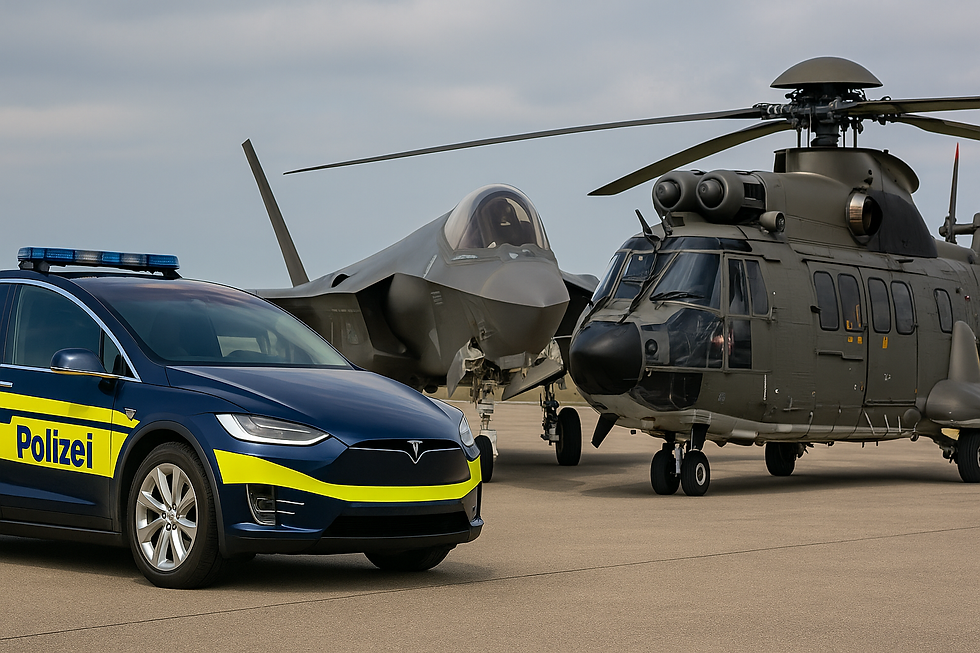From Police Patrol Cars to Fighter Jets: Lessons for Switzerland’s Potential Next Helicopter Purchase
- Nik Neshat

- Aug 13
- 4 min read

What do a Tesla police car, an F-35 fighter jet, and a Super Puma helicopter have in common? In Switzerland, they’re all chapters in the same public procurement story.
When Switzerland buys new military hardware, it is never just a technical transaction. It is a reflection of how we set priorities, safeguard public funds, and balance sovereignty with capability.
Two recent acquisitions — the Basel police’s Tesla Model X patrol fleet and the Air2030 F-35 fighter program — illustrate this point. Both purchases were driven by operational needs, yet each came with lessons on transparency, political risk, and total cost that should not be forgotten.
As the Swiss military prepares to potentially replace its aging Super Pumas and Cougars with new heavy-lift helicopters, these lessons matter more than ever. This is not about whether we choose a Boeing Chinook, a Sikorsky King Stallion, or something else entirely. It is about ensuring the process is rigorous, defensible, and delivers long-term value.
1. Transparency Is Non-Negotiable
The Basel police faced criticism for bypassing a formal public tender in their Tesla purchase. The F-35 program, by contrast, followed a structured competition and even went to a public referendum, giving it a legal foundation despite continued opposition.
For the potential helicopter purchase program, procurement experts suggest:
Running a fully transparent, competitive process.
Keeping a documented audit trail of every decision.
Involving oversight bodies early, not after controversy erupts.
2. Define Needs Before Naming Names
Tesla met Basel’s operational needs at the time, but critics suspected the specifications were written with a single supplier in mind. The F-35 process avoided this by defining capability criteria before naming competitors.
For the potential helicopter purchase program, procurement experts suggest:
Setting clear, capability-based requirements: lift capacity, range, interoperability, SAR readiness, life-cycle costs.
Avoiding criteria that inadvertently narrow the field too soon.
3. Look Beyond the Price Tag
Tesla’s higher upfront cost was offset by lower running costs but that story wasn’t told well before the purchase. The F-35’s projected lifetime savings now face uncertainty due to trade tensions.
For the potential helicopter purchase program, procurement experts suggest:
Analysing the total cost of ownership over 20–30 years.
Including maintenance, spare parts, upgrades, fuel/energy, and inflation.
Planning for political and currency risks.
4. Anticipate Political and Public Opinion
Basel’s Tesla rollout was delayed by data privacy concerns. The F-35 program won a referendum but still faces campaigns for cancellation.
For the potential helicopter purchase program, procurement experts suggest:
Addressing neutrality, cost, and environmental questions before they become flashpoints.
Communicating the civilian value of the fleet — disaster relief, search and rescue, jobs — alongside military roles.
5. Guard Against Vendor Lock-In
Tesla required technical changes to protect data sovereignty. The F-35 ties Switzerland to U.S. upgrade cycles and supply chains.
For the potential helicopter purchase program, procurement experts suggest:
Building local maintenance and technical capability into the deal.
Ensuring cybersecurity and data ownership from day one.
6. Secure Industrial Benefits
Tesla’s purchase brought little domestic industry benefit. The F-35 includes offset agreements supporting Swiss aerospace firms.
For the potential helicopter purchase program, procurement experts suggest:
Negotiating industrial participation that boosts Swiss aerospace, MRO capacity, and training.
Targeting skills and infrastructure that can serve both military and civilian sectors.
7. Build for the Future
Basel’s Teslas are lasting longer than planned, showing the value of flexibility. The F-35’s upgrade path keeps it relevant, but ties it to a single foreign supplier.
For the potential helicopter purchase program, procurement experts suggest:
Selecting a platform with modular upgrade potential.
Maintaining interoperability with evolving European standards.
A Swiss Procurement Leader’s Perspective
As a Swiss procurement leader who has managed the end-to-end acquisition of heavy machinery for Zurich Airport operation, from initial needs assessment to delivery and commissioning, I have lived these lessons. I have seen how quickly a procurement can be derailed by unclear specifications, limited competition, or underestimating operational realities. I have also seen the value of thorough stakeholder engagement, transparent evaluation, and future-proofed solutions. Applying that discipline to Switzerland’s helicopter program is not just good practice. It is essential if we are to secure capability, value, and public trust for decades to come.
Final Words
In the end, major procurements can also deliver pleasant surprises. Basel’s Teslas have shown remarkably low wear and tear, retaining high end-of-life value well beyond expectations. The F-35 program, despite its complexity, was ultimately backed by the Swiss public and holds strong potential to create jobs in Switzerland’s aviation sector while fostering valuable technology transfer. These outcomes echo three Swiss principles worth carrying forward: Zahlen, Daten, Fakten — decisions grounded in evidence; Demokratie — legitimacy through public voice; and Kollegialität — working together towards solutions that endure.*
*This article reflects the personal views and interpretations of the author, provided for informational purposes only, and does not constitute an official statement, advice, or position of any organisation or authority.
Fun Historical Fact: The history of Rega helicopters




Comments